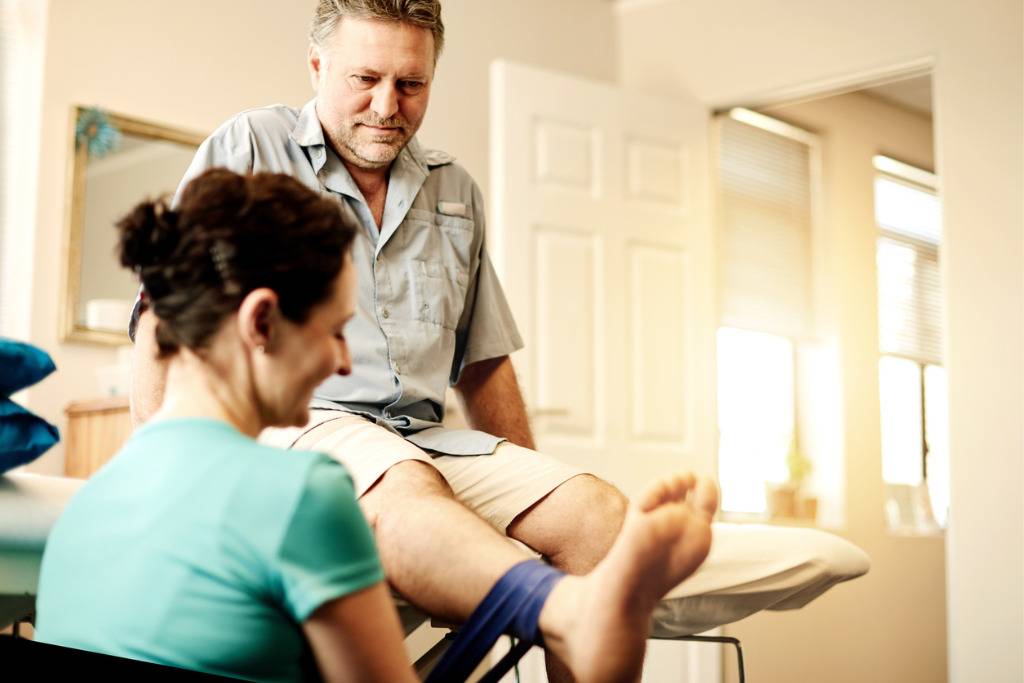Physical Therapy for Diabetes and Neuropathic Pain

Prevalence of neuropathic pain hovers at around seven to ten percent of the general population.1 While this percentage is already significant, peripheral neuropathy – which is characterized by weakness, numbness, or pain resulting from nerve damage – affects almost half the diabetic population.2 Peripheral neuropathy is often experienced in the hands or feet, although it is not limited to these areas. Often, individuals with peripheral neuropathy have polyneuropathy, in which many different nerves are affected. Patients who experience neuropathic pain often characterize it as a burning, piercing, or throbbing sensation.3 Physical therapy can be an important part of a treatment approach for neuropathic pain.
While the benefits of exercise and physical therapy for individuals with diabetes have been extensively characterized, less focus has been on its impact on neuropathic pain. In fact, it was previously thought that exercise and physical therapy may be contraindicated for those with peripheral neuropathy due to concerns that decreased sensitivity in the feet/arms could lead to injury. An important randomized control trial helped dispel these concerns by showing that the rate of foot ulcers, which are common in diabetes patients and can form due to a lack of sensation in the feet, obtained due to weight-bearing exercise was not increased in individuals with peripheral neuropathy as compared to unaffected controls.4
To further understand the possible role of physical therapy for the treatment of peripheral neuropathic pain, authors Kluding et al. performed an extensive review of the current literature. A number of studies have suggested that, contrary to previous belief, patients who participated in controlled exercise regimens through physical therapy demonstrated improved balance, gait, mobility, and nerve conduction velocity, all of which are correlated with decreased chronic pain.5,6 Conversely, individuals who have diabetes-related peripheral neuropathy and are less active are at heightened risk for adverse effects which may increase pain, such as breakdown of the skin.7 Given these findings, the authors argue the need for a paradigm shift in the way neuropathy is treated: like all tissue, tissue with peripheral neuropathy will respond positively to appropriate levels of stress imparted by physical therapy-mediated exercise.
One particularly effective approach for the treatment of neuropathic pain was physical therapy directed at neural mechanosensitivity, or the moving of specific peripheral nerves relative to the surrounding tissue. This can be accomplished either through exercises performed by the patient or direct application by the practitioner. Multiple studies showed improvement in neuropathy-related symptoms in patients who received neural management as compared to a control group. For example, a study by Rodriguez-Sanz et al. showed a statistically significant decrease in average pain scores (mean 3.7-point decrease) at week six of treatment in the experimental group undergoing neural tissue mobilization compared to the control group that did not undergo an intervention.8
Despite these encouraging findings, Kluding et al. were careful to reiterate that special accommodations and monitoring are a necessary part of physical therapy for diabetes and neuropathic pain. Given that each patient’s neuropathic pain is unique and may manifest itself differently – particularly when it comes to specific sensitivities or weaknesses – open communication between the patient and the physical therapist as well as flexible training plans are highly essential. Moreover, more research is needed to characterize the full potential of physical therapy on the treatment of diabetes and neuropathic pain. However, these findings do indicate that physical therapy-mediated exercise could be promising candidate for the management of neuropathic pain and diabetes.
References
[1] van Hecke, O., Austin, S. K., Khan, R. A., Smith, B. H., & Torrance, N. (2014). Neuropathic pain in the general population: a systematic review of epidemiological studies. Pain, 155(4), 654–662. https://doi.org/10.1016/j.pain.2013.11.013
2 Hicks, C. W., & Selvin, E. (2019). Epidemiology of Peripheral Neuropathy and Lower Extremity Disease in Diabetes. Current diabetes reports, 19(10), 86. https://doi.org/10.1007/s11892-019-1212-8
3 Mayo Foundation for Medical Education and Research. (2021, July 3). Peripheral neuropathy. Mayo Clinic. Retrieved from https://www.mayoclinic.org/diseases-conditions/peripheral-neuropathy/symptoms-causes/syc-20352061
4 Lemaster, J. W., Mueller, M. J., Reiber, G. E., Mehr, D. R., Madsen, R. W., & Conn, V. S. (2008). Effect of weight-bearing activity on foot ulcer incidence in people with diabetic peripheral neuropathy: feet first randomized controlled trial. Physical therapy, 88(11), 1385–1398. https://doi.org/10.2522/ptj.20080019
5 Lee, K., Lee, S., & Song, C. (2013). Whole-body vibration training improves balance, muscle strength and glycosylated hemoglobin in elderly patients with diabetic neuropathy. The Tohoku journal of experimental medicine, 231(4), 305–314. https://doi.org/10.1620/tjem.231.305
6 Richardson, J. K., Sandman, D., & Vela, S. (2001). A focused exercise regimen improves clinical measures of balance in patients with peripheral neuropathy. Archives of physical medicine and rehabilitation, 82(2), 205–209. https://doi.org/10.1053/apmr.2001.19742
7 Maluf, K. S., & Mueller, M. J. (2003). Novel Award 2002. Comparison of physical activity and cumulative plantar tissue stress among subjects with and without diabetes mellitus and a history of recurrent plantar ulcers. Clinical biomechanics (Bristol, Avon), 18(7), 567–575. https://doi.org/10.1016/s0268-0033(03)00118-9
8 Rodríguez-Sanz, D., López-López, D., Unda-Solano, F., Romero-Morales, C., Sanz-Corbalán, I., Beltran-Alacreu, H., & Calvo-Lobo, C. (2018). Effects of Median Nerve Neural Mobilization in Treating Cervicobrachial Pain: A Randomized Waiting List-Controlled Clinical Trial. Pain practice : the official journal of World Institute of Pain, 18(4), 431–442. https://doi.org/10.1111/papr.12614
